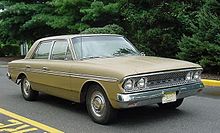Rambler Renault
Rambler-Renault was an automobile brand that existed from 1962 to 1971. The brand was created in the so-called badge engineering by merging the two brand names Rambler and Renault .
In the early 1960s, the so-called leap across the pond was a tempting business for many companies, especially the large corporations. These efforts were driven in particular by the fear of hostile takeovers by foreign corporations. This fear also existed in the Renault group during the time under the leadership of company president Pierre Dreyfus . The fear within the group was directed particularly towards the US corporations. The only way was to make a pact with the competing company or, if possible, to take over if possible.
A cooperation with the American Motors Corporation slowly came about. It was agreed to take over the assembly of certain car models of the opposing side for the respective other market. For the European market, Renault received the licenses for the Rambler Classic , which Renault assembled under badge engineering with almost identical equipment in the Belgian plant of Renault Industrie Belgique . It was the first model that was created as a result of the cooperation between the two groups, with the model being available in North America in a large selection of equipment variants and different body versions; there was no such diversity in Europe. The Rambler-Renault Classic was only available in all three generations as a four-door sedan with a notchback. The motorization also remained the same. The model had a six-cylinder in-line engine with a displacement of 3.2 liters under the bonnet. The engine output was 94 kW (128 hp).
The models of the Rambler-Renault brand were officially offered exclusively by Renault dealers in Algeria , Belgium , France , Hong Kong , Luxembourg , the Netherlands and Austria . Due to the size of the car model, many of the built units of the model, which is often classified as a road cruiser, were used by taxi companies. Due to the wear and tear, the models have become a rarity, which are currently of particular interest to collectors, enthusiasts and museums.
With the end of production of the Classic in the late 1960s, the model was replaced in Europe by the successor Rambler Rebel . While the Rambler brand name was abandoned in North America, double badge engineering was retained in Europe. This continued until 1971, when the assembly of the Rebel without a successor was discontinued. In contrast to its predecessors, the Rebel now also had the two-door hardtop coupe in addition to the four-door notchback sedan.
The units assembled in Haren - Vilvoorde can already be identified using the badge engineering on the rear of the vehicle. There is also a sign in the vehicle that indicates the assembly location in Brussels in the upper part . The exact type data can be read out in the middle part of the plate, and in the lower part of the plate is the name of the general importer who first sold the car. This varied from country to country. A second plate with the words Rambler Advanced Unit Construction contains the vehicle identification number for the respective vehicle, which at the time consisted of only eight digits. The code 6515 BEL is entered under Model on this plate for the Belgian units . All vehicle parts for the Rambler Renault models were manufactured at AMC in Kenosha in the USA .





